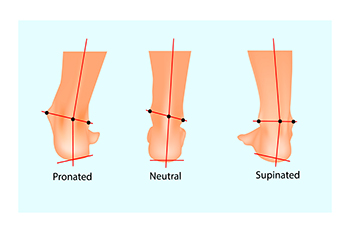Items filtered by date: March 2023
How Supination Can Affect Your Health

The way you walk can affect the health of your feet and other parts of the body. If your foot rolls outward when you walk it puts extra pressure on the outside of the feet. This action is termed supination, and it can induce pain as well as increase the chance of injury. Supination is thought to be caused by having a high arch and can be worsened if your footwear does not offer the proper support. Pain from supination can be felt in the feet, ankles, knees, hips, and lower back. It also increases the chances of sprains, strains, and shin splints. It has been found that certain orthotics can help to overcome this gait abnormality. Features that can help reduce the pain include arch support to keep the foot from rolling outward, a deep heel cup to help stabilize the heel, and extra cushioning for the foot. It is suggested that you consult a podiatrist who can examine your feet and create custom orthotics that will help counteract the problems of supination.
If you have any concerns about your feet, contact David K. Morris, DPM from Florida. Our doctor can provide the care you need to keep you pain-free and on your feet.
Biomechanics in Podiatry
Podiatric biomechanics is a particular sector of specialty podiatry with licensed practitioners who are trained to diagnose and treat conditions affecting the foot, ankle and lower leg. Biomechanics deals with the forces that act against the body, causing an interference with the biological structures. It focuses on the movement of the ankle, the foot and the forces that interact with them.
A History of Biomechanics
- Biomechanics dates back to the BC era in Egypt where evidence of professional foot care has been recorded.
- In 1974, biomechanics gained a higher profile from the studies of Merton Root, who claimed that by changing or controlling the forces between the ankle and the foot, corrections or conditions could be implemented to gain strength and coordination in the area.
Modern technological improvements are based on past theories and therapeutic processes that provide a better understanding of podiatric concepts for biomechanics. Computers can provide accurate information about the forces and patterns of the feet and lower legs.
Understanding biomechanics of the feet can help improve and eliminate pain, stopping further stress to the foot.
If you have any questions please feel free to contact our office located in Plantation, FL . We offer the newest diagnostic and treatment technologies for all your foot and ankle needs.
Who Is Susceptible to Cuboid Syndrome?

The cuboid bone is located near the heel and toward the outside of the foot. The foot condition known as cuboid syndrome may happen when the surrounding joints and ligaments become injured or move out of place. This can be a common injury among certain types of athletes, such as ballet dancers, or it may happen from suddenly twisting the ankle by falling. Existing conditions can make some prone to developing cuboid syndrome. These can include obesity and previously breaking a bone that is connected to the cuboid bone. Additionally, having various types of arthritis or osteoporosis can lead to getting cuboid syndrome. Relief is often found when the offending activity is temporarily stopped and the foot is frequently elevated. Effective prevention methods may come from adequately warming up and cooling down before and after a workout, and cross training may help to rest the feet. If you have pain in the outside of your foot, it is suggested that you confer with a podiatrist who can properly diagnose and treat cuboid syndrome.
Cuboid syndrome, also known as cuboid subluxation, occurs when the joints and ligaments near the cuboid bone in the foot become torn. If you have cuboid syndrome, consult with David K. Morris, DPM from Florida. Our doctor will assess your condition and provide you with quality foot and ankle treatment.
Cuboid syndrome is a common cause of lateral foot pain, which is pain on the outside of the foot. The condition may happen suddenly due to an ankle sprain, or it may develop slowly overtime from repetitive tension through the bone and surrounding structures.
Causes
The most common causes of cuboid syndrome include:
- Injury – The most common cause of this ailment is an ankle sprain.
- Repetitive Strain – Tension placed through the peroneus longus muscle from repetitive activities such as jumping and running may cause excessive traction on the bone causing it to sublux.
- Altered Foot Biomechanics – Most people suffering from cuboid subluxation have flat feet.
Symptoms
A common symptom of cuboid syndrome is pain along the outside of the foot which can be felt in the ankle and toes. This pain may create walking difficulties and may cause those with the condition to walk with a limp.
Diagnosis
Diagnosis of cuboid syndrome is often difficult, and it is often misdiagnosed. X-rays, MRIs and CT scans often fail to properly show the cuboid subluxation. Although there isn’t a specific test used to diagnose cuboid syndrome, your podiatrist will usually check if pain is felt while pressing firmly on the cuboid bone of your foot.
Treatment
Just as the range of causes varies widely, so do treatments. Some more common treatments are ice therapy, rest, exercise, taping, and orthotics.
If you have any questions, please feel free to contact our office located in Plantation, FL . We offer the newest diagnostic and treatment technologies for all your foot care needs.



